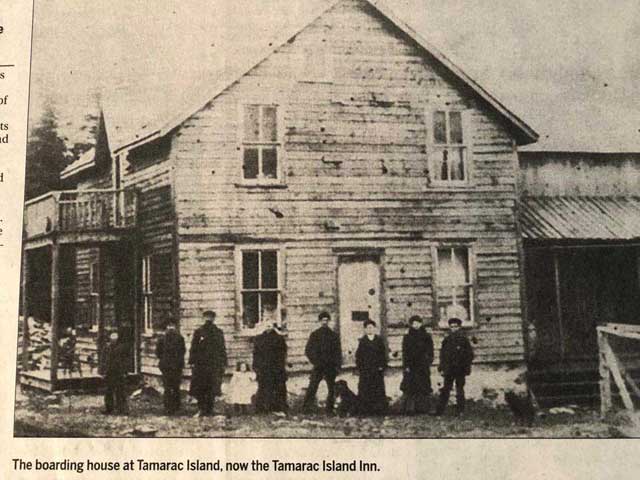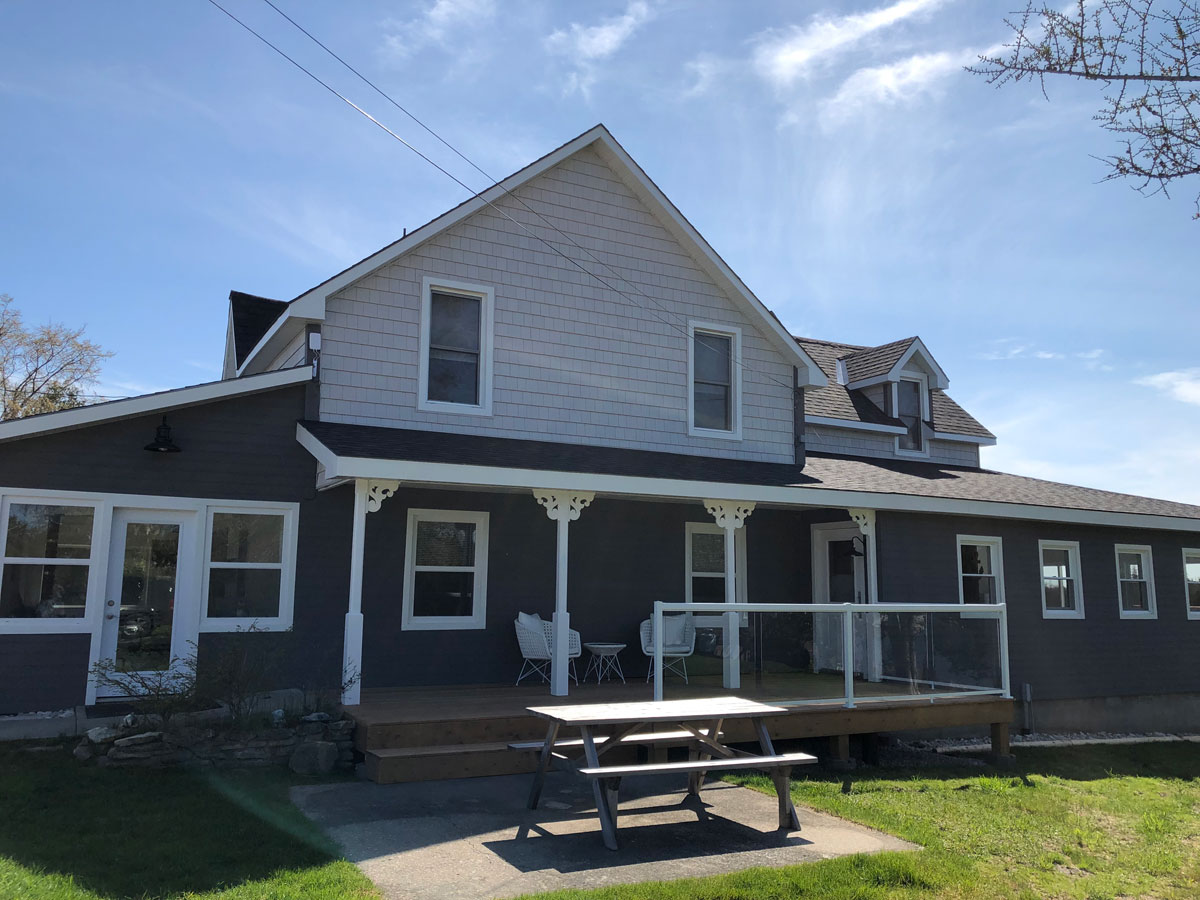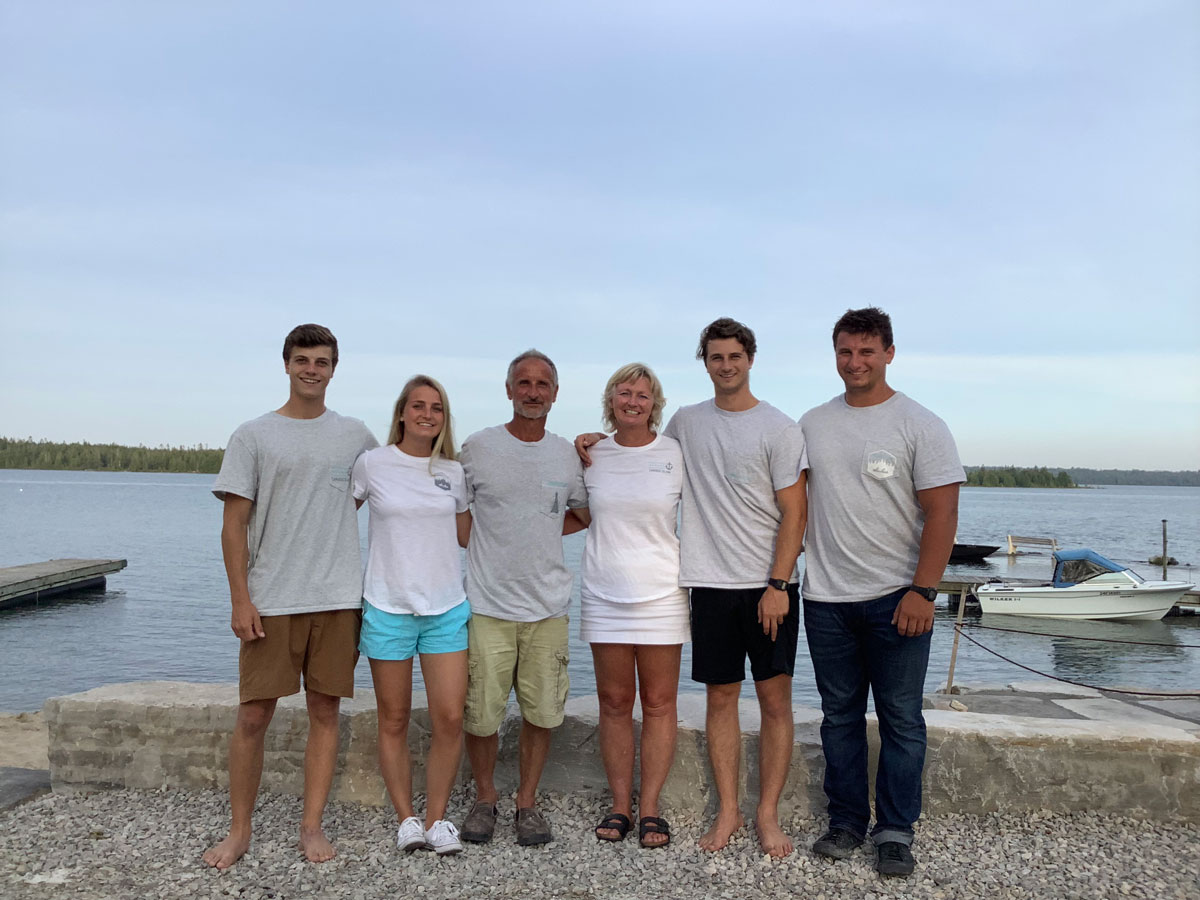THE HISTORY OF TAMARAC
From A Sawmill And Logging Camp to A Summer Vacation Wonderland!
The progress of a collection of buildings huddled on Tamarac Island in the beautiful bay of Stokes Bay from vigorous sawmill to vital sports club and naturalists’ retreat to popular vacation destination makes for fascinating history.
Tamarac Island lies west of the community of Stokes Bay on the Bruce Peninsula. Once a legendary logging site, today it is a thriving summer community filled with cottages and the Tamarac Island Inn. In the early days of the Peninsula when timber was the main cash crop, there were many mills in and around Stokes Bay. Tamarac Island was the site of one of the largest producing sawmills on the Bruce Peninsula. Some time around 1878, two men named Bible and Chisolm built the first mill on Tamarac Island. 15 of the island’s 60 acres were cleared, making room for a steam sawmill, boiler house, an office building, boarding house, acres of piled lumber, and a dock. In the early days, logs were floated down the Stokes River and other waterways on the Peninsula to the mill by means of log booms and held in the lagoon behind the mill until they could be processed. Railway ties and rough lumber were shipped by barge to American and Canadian markets. To connect the island with the main land, the owners built a causeway and bridge. They also built a dock on the western side of the island to facilitate the shipment of cut timber and then followed it up with a tram road that ran to Mud Lake and Clarke’s Corners.
The mill at Tamarac Island changed hands becoming the Lion’s Head Lumber Company, and then in 1899, the mill was sold to the Knechtel Furniture Company of Hanover. Knechtel’s owners were enticed by rumours of a railroad that was planned to link Wiarton and Tobermory. At the tip of the Bruce, a train-ferry service would then connect the rails with ones on Manitoulin and the North Shore. The directors of the Knechtel Company had a moment of jubilation when they discovered that the possible railway line up the Bruce ran directly through the centre of their timberlands. Now they could proceed with their plans to open the mill on Tamarac Island and even connect it by rail with the expected North Shore Railway. A foreman came up with the idea of building a tramway that would not only carry lumber from the sawmill to the bay where a dock built of slabs had been erected, but would eventually connect with the rumoured railway... A wooden railway track was laid on top of the tram road with the intention of running a small train and engine over it, hauling logs from the interior of the peninsula to the mill on Tamarac Island. Alas, the best-laid schemes of men sometimes go astray. A steam engine was brought up the peninsula, but once it was placed on the tram road, the wooden rails spread out like match sticks. The one and only train to ever run on the Bruce immediately jumped the tracks. It didn’t matter since the Bruce and North Shore Railway never materialized beyond rumours.
For the next dozen years, until the lumber ran out, the mill provided lumber for a generation of Knechtel furniture. Under the direction of their foreman, they harvested the hardwoods and some pine and hemlock, sending both logs and lumber by raft or steamer south along the Lake Huron coast to Southampton. At the peak of operation, up to 60 men were employed, some of whom brought their wives and families to live on the island. A small group of rough cottages dotted the northeasterly end of the island close to the mill, along with a large nine bedroom house where meals were served to famished lumberjacks.


In 1911, a turning point occurred in the life of the property when the local timber supply was depleted, and the mill was closed down. By 1911, all that was left of the Knechtel forest reserves were 7,000 acres of cut-over land covered with slash and an ever-threatening cause for fire. W. Sherwood Fox, in his book The Bruce Beckons, quotes an old timer who recalled being present on that day in 1911, when,
“the last whistle blew to stop work. Everyone there knew what it meant, and we were all solemn…but somehow we felt that in that little world of rock, water and exhausted forest a new local era was beginning: In short, we felt that somebody had ‘started something’. But little did we realize that that something was much more than a mere band of anglers and hunters bent apparently only on health and pleasure, but rather a progressive and contagious influence working towards a sound restoration of the wealth of the wilderness”.
With the forest gone, sportsmen did indeed arrive on the scene. At that time in the years just before the First World War, the peninsula was a sportsmen’s paradise, alive with waterfowl, wildlife, and fish, still in great numbers. In 1913, Tamarac was sold to a group of men who formed a hunting and fishing club. It was incorporated as Tamarac Fishing and Shooting Club. Among them were lumbermen and manufacturers from Hanover and Walkerton. What Fox was referring to was the decision of the owners to turn the facilities so fortunately situated on a beautiful site by clear waters with abundant fish into a sportsmen’s retreat. The old boarding house and mill buildings were used by club members as a dining hall and sleeping quarters. The years passed and the club members grew older and sometime in the 1960s, the club became inactive.
In 1986, the island began to take on a new profile. The decision of the club to and sell the island as residential seasonal parcels became the good fortune of approximately 30 families. Doug McLay, who owned Davis and McLay Real Estate and Developments, and who was born and raised in Stokes Bay, was retained to develop Tamarac Island. He surveyed the island, cut the roads and drive ways, and sold the lots. The largest parcel was purchased by Mel and Bev Matheson. It included a six-unit motel, the original boarding house and the sawmill. The new owners prided themselves on the homemade fare the Inn offered and also their determination to maintain the old as well as to create the new. The sawmill was, unfortunately, beyond repair, but as much material as possible was salvaged to refurbish the Inn, inside and out. They added a charming little cottage on the site of the original mill. The Mathesons were hosts to guests from near and far. Included in the names on the register was Kleinschroth, both George and John of Calgary whose grandfather was foreman of the mill for eleven years. In 1988, Lyda Kleinschroth Bach (the daughter of the foreman, Henry Kleinschroth), visited. Lyda was born in the Inn in 1904 and lived there until she was 7 years old. The Mathesons were impressed with Lyda’s memories of those early years in the old house when her father worked in the mill. Lyda made the history of the place come alive with her recollections.
Tamarac Island Inn would change hands three times after that, until the current owners, Serge Marcella, Melony McLay, and their four children purchased the property in 2017. They immediately set about to restore the property and, much like the Mathesons before them, were determined to keep some of the history, charm, and quirkiness of the original property. Paying a visit to Tamarac Island Inn and Motel means driving across the causeway and past the original stone structure of the once upon a time sawmill, and there the Inn stands, its outlines looking much like they did more than a century ago. While maintaining the original bones of the building, including the butler’s stairs from the living quarters to the kitchen, the Inn was outfitted with all new electrical, plumbing, interior, and exterior. The exterior lends a nod to coastal living with its grey wood siding and shakes, white accents, massive decks, and a round nautical window peeking out on the second story. The interior has a clean, fresh and light feel with white painted shiplap, laid back coastal/cottage furnishings, and beachy linens.
Today, the Tamarac Island Inn also has a wonderful collection of old photographs of fishermen and their catch. Faded a bit, they are a reminder of the glory days of angling on the Bruce Peninsula. The other tangible reminder of days gone by is the many slabs, some potentially more than 140 years old, that can be seen on the bottom of the lake around the dock.
Melony and Serge and family welcome guests from around the world to the motel, cottage and Inn, a popular vacation destination. Tamarac Island is also home to them because they love being surrounded by water, boating, fishing, family times, and are now happy to share their beautiful property and its rich history with their guests.









